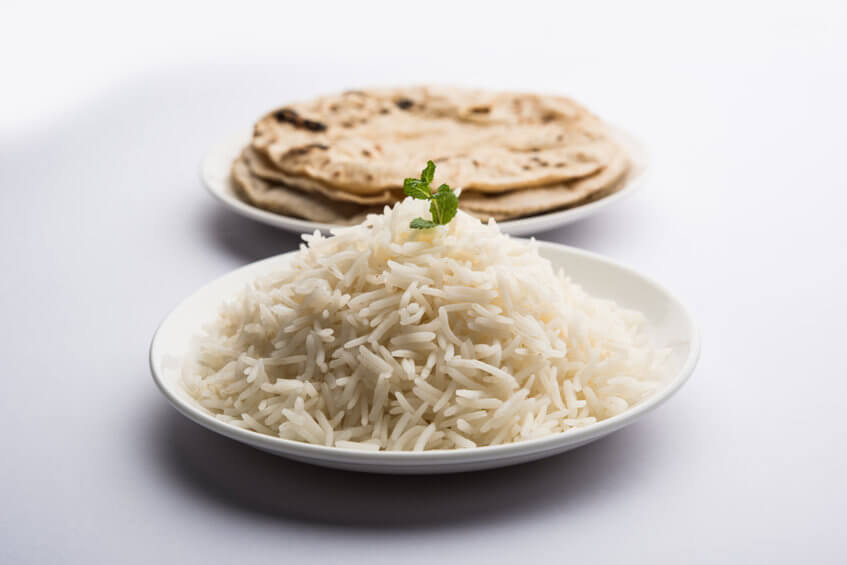Are you caught up in the Basmati rice vs brown rice debate? As we all know, Basmati rice is considered one of the healthiest types of rice available in the market. On the other hand, brown rice can be regarded as slightly inferior compared to its cousin. But is this really true? The purpose of this article is to shed some light on a little-known fact – Basmati rice and brown rice are not necessarily different!
In short, the main difference between Basmati rice vs brown rice is that brown rice has more fiber and protein, whereas Basmati rice has fewer calories and fewer grams of fat.
Basmati Rice

Basmati is long-grain white rice grown in India and Pakistan. Its name derives from the Hindi word “vasmati,” meaning “fragrant.”
According to the Whole Grains Council, basmati rice has a nutty aroma and flavor with a fluffy texture when cooked properly. It is relatively high in carbohydrates but contains no cholesterol or sodium. Basmati contains small amounts of vitamins B-6, thiamine, and niacin. One cup of cooked Basmati provides about 200 calories, 5 grams of protein, and 45 grams of total carbohydrates.
Basmati Rice is a variety of long-grain rice that originates from India and Pakistan. It’s grown worldwide, including in the U.S., and it comes in both white and brown varieties. Basmati rice is also one of the oldest foods on earth, as it’s been around for over 7,000 years. And it’s even mentioned in some ancient texts and religious books like the Quran and Vedas.
Brown Rice

Brown rice is whole-grain rice with its husk, bran, and germ removed. The milling process of brown rice removes only the outermost layer, known as the hull. After removing the hull, the brown part of the rice is left behind, hence its name.
According to the USDA nutrient database, brown rice has fewer calories than white rice: a half-cup serving has 108 calories versus 205 in white rice. Brown rice also has twice as much fiber and protein as white rice. Brown basmati rice and other varieties are available at most grocery stores.
Brown rice has the same nutritional value as white rice but more fiber and fewer calories, fat, and carbs. It also has more protein than white rice, which means it can help you feel fuller for longer. And brown rice takes longer to digest than white rice, which means it will keep you feeling full for hours after eating it.
Basmati Rice VS Brown Rice: Nutrition Facts
Having both Brown and Basmati rice on a weekly basis is a great way to ensure you’re eating healthy while still enjoying the foods you love. However, is one of them is undoubtedly healthier than the other?
Which one is it, Basmati rice or brown? Let’s have a look at the nutrition data.
A 1/4 cup dry serving of Lundberg California White Basmati Rice contains the following:
- Calories: 160
- Total Fat: 0.5 g
- Total Carbohydrate: 36 g
- Dietary Fiber: 0 g
- Protein: 3 g
On the other hand, a 1/4 cup dry serving of Long Grain Brown Rice contains:
- Calories: 171
- Total Fat: 1.4 g
- Total Carbohydrate: 35.7 g
- Dietary Fiber: 1.6 g
- Protein: 3.7 g
You don’t need a registered dietitian or nutritionist to tell you it’s brown rice. With its higher fiber content, larger meals that are lower in calories, and high levels of disease-fighting antioxidants, it’s clear that brown rice leaves the Basmati behind in terms of health benefits.
While they have similar nutrition facts, there are also some differences between Basmati and brown rice in terms of their nutritional value. For instance, brown rice has more fiber than basmati rice, which means it will keep you feeling full for longer after eating it.
Brown Rice Has More Fiber
Brown rice has more fiber than white or brown basmati rice. Expert research has shown that brown rice has a higher fiber content than other types of rice. Brown rice has more soluble fiber, insoluble fiber, and resistant starch than Basmati rice.
The difference in Basmati rice vs brown rice fiber content may be because brown rice is less processed. Less processing means that the bran and germ stay intact. These components of the rice grain are where the most nutrients can be found, including dietary fiber and many vitamins and minerals. The researchers also found that white rice contains more fat and sugar than brown rice. Overall, brown rice was the healthier choice for people with diabetes.
Brown rice contains three to four grams of fiber per serving. This type of rice can help you meet the daily recommended amount of fiber intake – 25 grams for women and 38 grams for men – with one cup (or eight ounces).
According to an article published in the PubMed reading “Dietary Fiber,” increasing your consumption of dietary fiber can lower your risk factors for cardiovascular disease and diabetes while helping you maintain a healthy weight.
Diets rich in fiber can help you remain full throughout the day, which means you’re less likely to snack on unhealthy foods. Fiber-rich foods take longer to eat and digest, which can help you feel full for longer. Fiber also has fewer calories – a cup of raspberries contains about 64 calories and about 8 grams of fiber.
Fiber can also help prevent constipation and promote regularity for a healthy digestive tract. Fiber can also help lower cholesterol levels and help prevent heart disease by flushing out bad cholesterol from your body before it gets a chance to stick to your arteries.
Brown Rice Has More Protein

Brown rice has more protein than white or brown basmati rice. Protein is crucial for building muscle mass, repairing tissue, fighting infection, and maintaining a healthy weight. Protein also helps control your appetite by making you feel fuller longer than you would after eating foods high in carbohydrates and fat.
Protein plays a role in virtually every bodily function, carrying oxygen through your blood to muscles via hemoglobin in red blood cells. Most whole grains have little or no protein compared with meats, poultry, seafood, and dairy products.
In 1 cup (195 grams) of cooked long-grain brown rice, there are 5 grams of protein. The same serving of cooked basmati rice has 4 grams. Brown rice had a significant increase in protein content compared to Basmati rice, while there was no difference in the amount of protein present between starch types of brown rice. This indicates that the extra proteins originate from the seed coat, which is removed to produce white rice.
Still, both types are considered low-protein foods compared to animal sources like meat and eggs. The recommended daily intake (RDI) for protein is 46-56 grams per day for women and 56-91 grams/ day for men.
Basmati Rice Has Fewer Calories
The ongoing conversation about the health benefits of a low-carb or low-fat diet has given rise to the idea that Basmati rice is a healthier alternative to the regular, long-grained variety. The science behind this claim is that Basmati rice contains resistant starch, which reacts differently with the body than other starches and has lesser calories.
This is important because you can eat more of it without increasing your calorie intake for the day. If you’re trying to lose weight or just want to eat as healthily as possible, it’s best to go with Basmati.
For many people choosing between Basmati rice vs brown rice, the later is often considered healthier than white rice because it is less processed. However, white basmati rice has a lower glycemic index (GI). Because of this, basmati rice may be a better choice for people with diabetes trying to keep their blood sugar under control.
The GI measures how quickly foods raise blood sugar levels. The higher the number, the more pronounced the effect on blood sugar. Basmati rice has a GI of 58, while Brown has 50. That’s still much lower than white rice – which can have a GI as high as 89 – but it does mean that Basmati will raise your blood sugar somewhat faster than whole-grain Brown.
Basmati Rice Has Less Fat
It’s no secret that brown rice is better for you than white rice. The “brown” in brown rice comes from the germ, containing healthy oils and vitamins. The exterior husk of the grain is removed to make white rice. But, where does basmati rice fall? Basmati is an aromatic variety of long-grain rice in white and brown. Like all brown kinds of rice, the whole grain has more nutrients and protein than white. However, brown Basmati has less fat than regular brown rice.
When a grain is milled to produce white rice, the bran layer containing a significant oil is removed. This oil causes white rice to spoil faster than brown because it contains more fat, turning rancid over time. While the germ also contains some oil, this nutrient-rich layer has significantly less oil than the bran. Therefore, brown Basmati has less fat than regular brown rice because it has less bran.
Both white and brown Basmati have fewer calories per serving than regular white or brown rice because they are lengthy-grain varieties with fewer carbohydrates per serving size.
Conclusion
Still, need to choose between Basmati rice vs brown rice? Basmati rice is a long-grain food that humans have used for thousands of years. Brown rice, on the other hand, is the result of a unique process that removes the hull and bran of the grain while preserving its high amounts of fiber.
Though they may sound different and look marginally different, they are essentially two peas in a pod. Both Basmati and brown rice are healthy options, and the one you should choose depends on your own dietary needs. Brown rice is richer in fiber and nutrients than white (or polished) rice. Basmati rice has a lower glycemic index than other types of long-grain rice, which raises blood sugar levels slowly.

